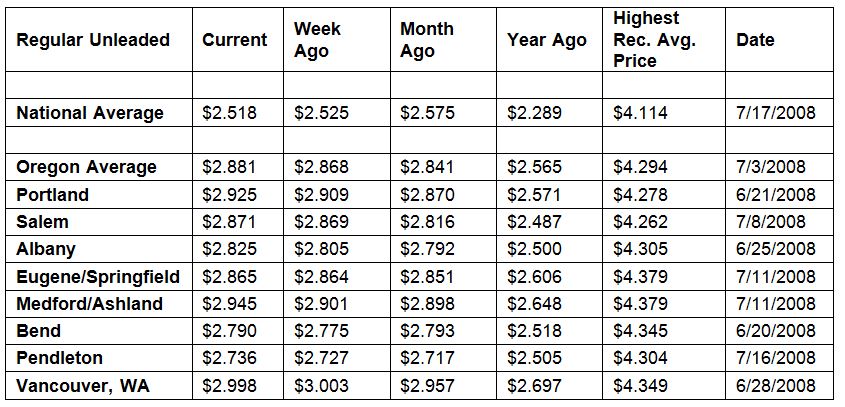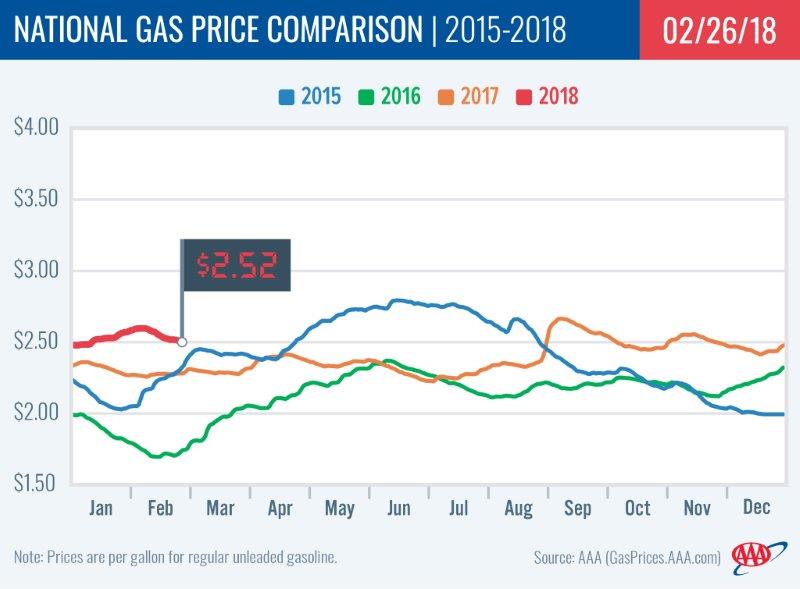AAA Expects Prices to Climb Soon
PORTLAND, Ore., – Pump prices are fairly stable for the week, with many states showing small increases or decreases. For the week, the national average for regular unleaded slips a penny to $2.52 a gallon while the Oregon average ticks up a penny to $2.88. Both averages remain lower than their year-to-date highs. The national average peaked for the year so far at $2.61 on Feb. 5, while the Oregon average peaked at $2.90 on Feb. 7 through 9.
“Demand for gasoline has decreased for the last two weeks and that’s helping to keep pump prices in check for now. However, AAA says they’ll start rising again soon. Refinery maintenance season is getting underway and this is the time of year we normally see people start to drive more,” says Marie Dodds, public affairs director for AAA Oregon/Idaho. “AAA expects gas prices to climb to their spring highs between around April 1 and June 21. Spring prices will be higher than the last couple of years, but likely not as expensive as in 2014 when the national average peaked at $3.70 and the Oregon average peaked at $3.99.”
Even with the small decline, demand for gasoline demand continues to register above 9 million b/d, which is a four percent year-over-year increase, according to the latest report from the U.S. Energy Information Administration (EIA). Due to Hurricane Harvey last fall, many Gulf Coast refineries delayed maintenance which will have to be performed this spring. Refinery maintenance season is normally about 90 days long.
Oregon is one of 14 states where gas prices are higher week-over-week. The largest increase is in Michigan (+4.5 cents). The largest decrease is in New Jersey (-3 cents). The average in Montana remains the same this week.
Oregon is one of seven states where prices are higher now than a month ago. The national average is six cents less and the Oregon average is four cents more than a month ago. The largest monthly increases are in California (+9 cents) and Hawaii (+9 cents). The largest monthly decrease is in Ohio (-17 cents).
The West Coast still has the most expensive gas prices in the nation with six of the top ten states in this region. Hawaii tops the list, followed by California, Alaska. These states are the only three with averages at or above $3 a gallon. Washington is fourth. Oregon is fifth most expensive for the fourth week in a row.
| Rank | Region | Price on 2/27/18 |
| 1 | Hawaii | $3.48 |
| 2 | California | $3.34 |
| 3 | Alaska | $3.03 |
| 4 | Washington | $2.99 |
| 5 | Oregon | $2.88 |
| 6 | Pennsylvania | $2.81 |
| 7 | Nevada | $2.79 |
| 8 | District of Columbia | $2.75 |
| 9 | New York | $2.72 |
| 10 | Connecticut | $2.70 |
According to the EIA, gasoline inventories in the region fell slightly for the second week. Inventories still sit at a comfortable 34.2 million bbl, which is nearly 4 million bbl higher than they were at this time last year.
The nation’s cheapest markets are Texas ($2.25) and South Carolina ($2.25). For the 31st week in a row, no states have an average below $2.
Drivers in all 50 states and the District of Columbia are paying are paying more than a year ago to fill up. The national average is 23 cents more and the Oregon average is 32 cents more than a year ago. This is the third-largest yearly increase in the country. Hawaii has the greatest year-over-year increase of 39 cents; California is second at 38 cents.
Oil Market Dynamics
Crude oil prices remain above the $60 per barrel mark, after retreating below $60 earlier this month for the first time in 2018. Oil prices are likely to remain strong this week after the EIA’s latest petroleum report revealed that U.S. crude inventories unexpectedly fell by 1.6 million barrels. The drop made some market observers believe that growth in global demand this year may help drain global inventories further, even with U.S. production continuing to grow.
EIA’s report also found that U.S. domestic crude production and exports remain high, hitting 10.270 million b/d and 2.04 million b/d respectively. A steady increase in crude oil exports underscores that growth in domestic production has led to the U.S. ability to meet growth in global appetite for oil. The growth and price gains for crude since the end of last year have helped to drive additional investment in drilling activity in the U.S., which currently has 799 active oil rigs, according to Baker Hughes, Inc.
At the close of Friday’s formal trading session on the NYMEX, WTI increased 78 cents to settle at $63.55. At the close of Monday’s formal trading session on the NYMEX, WTI increased 36 cents to settle at $63.91. Today crude is trading around $63, compared to $62 a week ago. Crude prices are down about four percent in the last month and are about $9 more per barrel than a year ago.
Drivers can find current gas prices along their route with the free AAA Mobile app for iPhone, iPad and Android. The app can also be used to map a route, find discounts, book a hotel and access AAA roadside assistance. Learn more at AAA.com/mobile.
Diesel
For the week, the national average slips a penny to $2.95 a gallon. Oregon’s average holds steady at $3.07. A year ago the national average for diesel was $2.52 and the Oregon average was $2.68.
Find current fuel prices at GasPrices.AAA.com.
AAA news releases, high resolution images, broadcast-quality video, fact sheets and podcasts are available on the AAA NewsRoom at NewsRoom.AAA.com.



